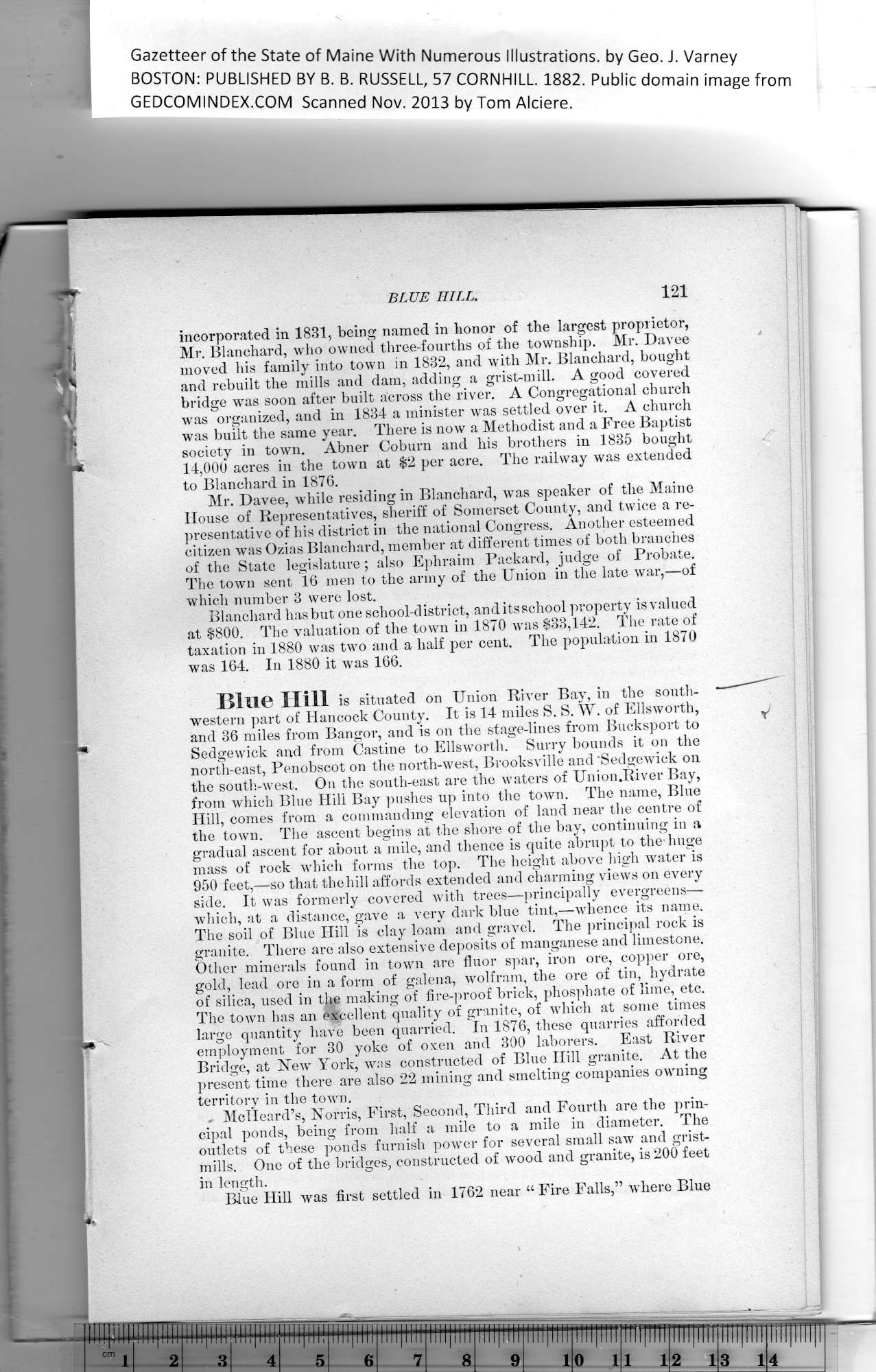|
Gazetteer of the State of Maine With Numerous Illustrations, by Geo. J. Varney
BOSTON: PUBLISHED BY B. B. RUSSELL, 57 CORNHILL. 1882. Public domain image from
BLUE HILL.
incorporated in 1831, being named in honor of the largest proprietor,
Mr. Blanchard, who owned three-fourths of the township. Mr. Davee
moved his family into town in 1832, and with Mr. Blanchard, bought
and rebuilt the mills and dam, adding a grist-mill. A good covered
bridge was soon after built across the river. A Congregational church
was organized, and in 1834 a minister was settled over it. A church
was built the same year. There is now a Methodist and a Free Baptist
society in town. Abner Coburn and bis brothers in 1835 bought
14,000 acres in the town at $2 per acre. The railway was extended
to Blanchard in 1876.
Mr. Davee, while residing in Blanchard, was speaker of the Maine
House of Representatives, sheriff of Somerset County, and twice a re-
presentative of his district in the national Congress. Another esteemed
citizen was Ozias Blanchard, member at different times of both branches
of the State legislature ; also Ephraim Packard, judge of Probate.
The town sent 16 men to the army of the Union in the late war,—of
which number 3 were lost.
Blanchard has but one school-district, and its school property is valued
at $800. The valuation of the town in 1870 was $33,142. The rate of
taxation in 1880 was two and a half per cent. The population in 1870
was 164. In 1880 it was 166.
Blue Hill is situated on Union River Bay, in the south-
western part of Hancock County. It is 14 miles S. S. W. of Ellsworth,
and 36 miles from Bangor, and is on the stage-lines from Bucksport to
Sedgewick and from Castine to Ellsworth. Surry bounds it on the
north-east, Penobscot on the north-west, Brooksville and ‘Sedgewick on
the south-west. On the south-east are the waters of Union.River Bay,
from which Blue Hill Bay pushes up into the town. The name, Blue
Hill, comes from a commanding elevation of land near the centre of
the town. The ascent begins at the shore of the bay, continuing in a
gradual ascent for about a mile, and thence is quite abrupt to the huge
mass of rock which forms the top. The height above high water is
950 feet,—so that the hill affords extended and charming views on every
side. It was formerly covered with trees—principally evergreens—
which, at a distance, gave a very dark blue tint,—whence its name.
The soil of Blue Hill is clay loam and gravel. The principal rock is
granite. There are also extensive deposits of manganese and limestone.
Other minerals found in town are fluor spar, iron ore, copper ore,
gold, lead ore in a form of galena, wolfram, the ore of tin, hydrate
of silica, used in the making of fire-proof brick, phosphate of lime, etc.
The town has an excellent quality of granite, of which at some times
large quantity have been quarried. In 1876, these quarries afforded
employment for 30 yoke of oxen and 300 laborers. East River
Bridge, at New York, was constructed of Blue Hill granite. At the
present time there are also 22 mining and smelting companies owning
territory in the town.
McTIeard’s, Norris, First, Second, Third and Fourth are the prin-
cipal ponds, being from half a mile to a mile in diameter. The
outlets of these ponds furnish power for several small saw and grist-
mills. One of the bridges, constructed of wmod and granite, is 200 feet
in length.
Blue Hill was first settled in 1762 near “Fire Falls,” where Blue
PREVIOUS PAGE ... NEXT PAGE
This page was written in HTML using a program written in Python 3.2
|
